Samsung Unpacked 2021 Part 2: Galaxy Z Flip 3 & Z Fold 3 Announced
by Andrei Frumusanu on August 11, 2021 10:00 AM EST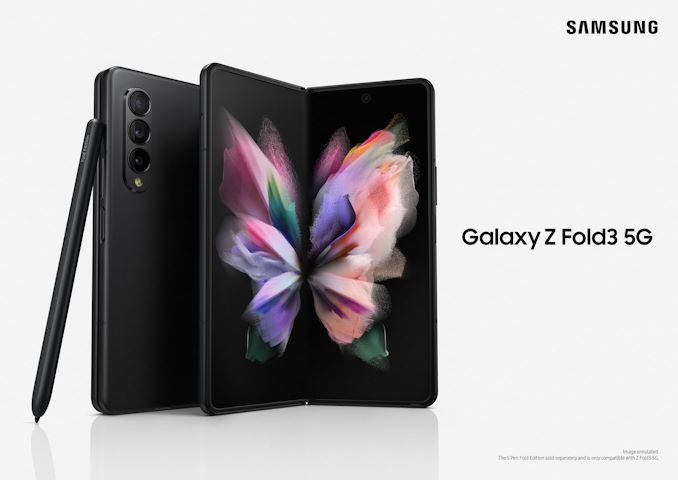
Today Samsung is holding its second Mobile Unpacked event for the year, announcing the new Galaxy Z Flip 3 and the new Galaxy Z Fold 3. It’s a bit of an unusual Unpacked event compared to past years as this time around and for this year we won’t be seeing a new Galaxy Note device.
The new Galaxy Z devices follow as iterations to their predecessors – the original Z Flip announced in February last year and Z Flip 5G later in August, and the Z Fold 2 which was also announced around the same time in 2020.
Both devices are obvious characterised by their folding form-factor designs, which Samsung this year has iterated on, included new hardware internals, and generally just polished their functionality compared to their predecessors. Samsung’s focus towards foldables seems to result as the market generally is finding it hard to differentiate oneself in-between competitors.
| Galaxy Z Phones 2021 | |||
| Galaxy Z Flip 3 | Galaxy Z Fold 3 | ||
| SoC | Qualcomm Snapdragon 888 1x Cortex-X1 @ 2.84GHz 3x Cortex-A78 @ 2.42GHz 4x Cortex-A55 @ 1.80GHz Adreno 660 @ 840MHz |
||
| DRAM | 8GB LPDDR5-6400 | 12GB LPDDR5-6400 | |
| Primary Display | 6.7" AMOLED 2640 x 1080 120Hz Refresh |
7.6" AMOLED Foldable 2208 x 1768 120Hz Refresh |
|
| Secondary Display | 1.9" 260 x 512 |
6.2" AMOLED 2260 x 832 120Hz Refresh |
|
| Size | Height | 166mm (unfolded) | 158.2mm |
| Width | 72.2mm | 67.1mm (folded) 128.1mm (unfolded) |
|
| Depth | 15.9 - 17.1mm (folded) 6.9mm (unfolded) |
14.4 - 16.0mm (folded) 6.4mm (unfolded) |
|
| Weight | 183g | 271g | |
| Battery Capacity | 3300mAh (Typical) 15W |
4400mAh (Typical) 25W |
|
| Wireless Charging | 10W | 10W | |
| Rear Cameras | |||
| Main | 12MP 1.4µm DP PDAF f/1.8 OIS 26.8mm eq. |
12MP 1.8µm DP PDAF f/1.8 OIS 26.8mm eq. |
|
| Telephoto | - |
12MP 1.0µm f/2.4 OIS 51mm eq. |
|
| Extra Telephoto |
- | - | |
| Ultra-Wide | 12MP 1.12µm f/2.2 123° FoV / 13mm eq. |
||
| Extra | - | - | |
| Front Camera | Hold-Punch (Unfolded) 10MP 1.22µm f/2.2 25.7mm eq. |
Under-Display (unfolded) 4MP 2.0µm f/1.8 Hole-Punch (folded) 10MP 1.22µm f/2.2 25.7mm eq. |
|
| Storage | 128 / 256GB UFS 3.1 |
256 / 512GB UFS 3.1 |
|
| I/O | USB-C | ||
| Wireless (local) | 802.11ax (Wifi 6), Bluetooth 5.1 |
802.11ax (Wifi 6E), Bluetooth 5.2 |
|
| Cellular | 4G + 5G NR NSA+SA Sub-6GHz + mmWave | ||
| Special Features | Under-screen fingerprint sensor Stereo speakers It flips |
Under-screen fingerprint sensor Stereo speakers It folds |
|
| Splash, Water, Dust Resistance | IPx8 | IPx8 | |
| Dual-SIM | nano-SIM + eSIM | 2x nano-SIM + eSIM | |
| Launch OS | Android 11 w/ OneUI 3.1 | ||
| Launch Price | 8+128GB: $999 / 1059€ 8+256GB: $ / 1109€ |
12+256GB: $1799 / 1799€ 12+512GB: $ / 1899€ |
|
Starting off with the hardware, the new Galaxy Z devices are now powered by Qualcomm’s new Snapdragon 888 chipset for all global variants of the phones, which should give the phones excellent performance. It’s to be noted that these foldable phones have likely less thermal dissipation capabilities as the more traditional “bar” style devices, so it’ll be interesting to see how Samsung handles the increased power envelope of the new SoC compared to last year’s Snapdragon 865.
The phones come with 8GB of RAM on the Z Flip 3 and 12GB on the Z Fold 3. Storage options for the Flip are 128 or 256GB, while the Fold doubles it to 256GB or 512GB – both UFS 3.1.
The Z Fold 3’s overall design hasn’t changed all that much from the Z Fold 2 – the internal screen is still a 7.6” 2208 x 1768 plastic AMOLED panel with the notable characteristic that it is flexible and foldable. It also continues the 120Hz refresh rate.
The larger change on the panel isn’t in regards to the panel itself but rather to the front camera, which is now using Samsung’s first ever iteration of an under-screen camera design. The camera sits underneath the screen panel and “sees through” the pixel matrix, which is now partially transparent besides for the actual pixel emitters. Samsung here only uses 4MP camera module, but with large 2µm pixels. The pixel density of the area above the camera module does not appear as dense as what we’ve seen presented by Xiaomi on the MIX4, however Samsung is deploying this technology on a foldable panel first so there might be larger differences and technical limitations to the various implementations.
What’s novel on the Fold 3 is the fact that Samsung has now also introduced a digitizer into the panel, allowing it to work alongside the S-Pen. Samsung has also introduced a new S-Pen with a rubber nib and spring pressure mechanism that is much gentler to the plastic screen compared to the traditional S-Pens for glass screens.
On the cover side of the Z Fold 3 we again also see a similar 6.2” display, although this year this panel has gained 120Hz refresh rate capabilities. The camera employed here is of the more traditional hole-punch design.
The overall dimensions of the Z Fold 3 are similar to its predecessor, a 158.2mm device height, and a folded with of 67.1mm that opens up to 128.1mm when unfolded. The device thickness is 6.4mm when unfolded, or 14.4mm when folded. The phone still remains extremely heavy at 271g, but does shave off a few grams compared to its predecessor. Included in that weight is a 4400mAh battery.
Samsung has introduced IPx8 rating for the new Z devices, meaning they’re now water resistant – which is actually quite a feat for a foldable device. Samsung has managed this to employ corrosion resistant mechanical elements in the hinge design, and enforcing water resistant rubber between the electrical elements of the two phone halves.
In terms of cameras, the Z Fold 3 does not appear to change anything in regards to the actual hardware: it’s still a 12MP 1.8µm sensor with f/1.8 as the main module, the same as we’ve seen on the S20 and S21 series. There’s a 2x optical 12MP 1.0µm f/2.4 with OIS telephoto module, and a 12MP 1.12µm ultra-wide with 13mm/123° FoV optics.
The Z Flip 3 differs from the Fold in that it folds in the vertical direction of a more classical flip-phone, rather than horizontally as its larger sibling. Similar to the Z Fold 3, the generational changes this year are rather minor besides the internal hardware upgrade.
In terms of design and the display, it’s again still a 6.7” 2640 x 1080 panel, but this year does gain 120Hz refresh rate.
The secondary small display on the rear of the phone has grown from 1.1” to 1.9” and is of a 260 x 512 resolution now, and in general the whole rear part of the phone here is quite different from the Z Flip 2 as Samsung has rearranged the two rear cameras in a vertical positioning alongside the larger secondary rear display.
Unfortunately, the camera hardware doesn’t seem to have seen upgrades, the main module is still a 12MP 1.4µm f/1.8 module (Galaxy S10 class generation), and the same 12MP 1.12µm specifications on the ultra-wide sensor.
Rather conservative upgrades
In general, this year’s Galaxy Z devices are really only evolutionary upgrades over last year’s options. While the Z Flip 3 has seen what I would call larger differentiation through the larger secondary display and camera rearrangement, the Z Fold 3, beyond the camera island redesign, can also only be really differentiated through the new under-screen inner front camera module.
While the Z Fold 3 remains extremely expensive starting at $1799, the Z Flip 3 starts a lower $999, $200 less than its predecessor, which might open up the phone to a larger potential audience.


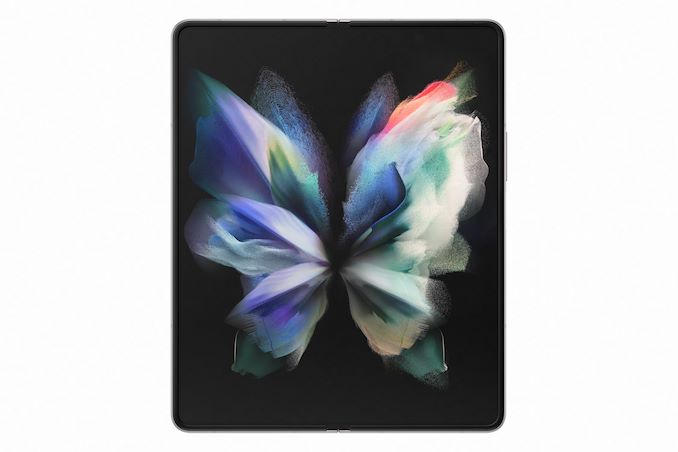
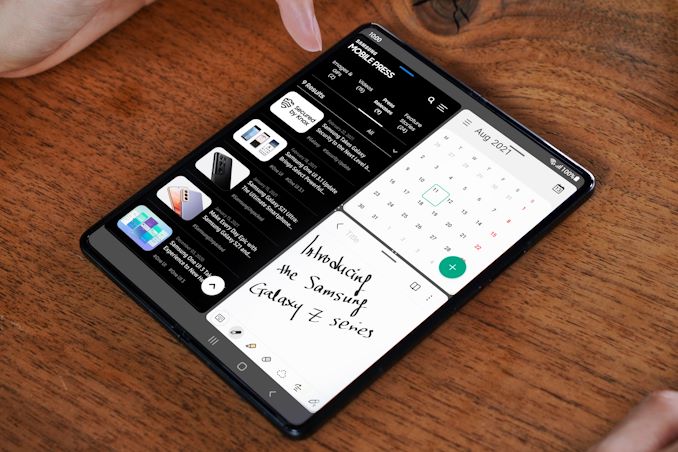
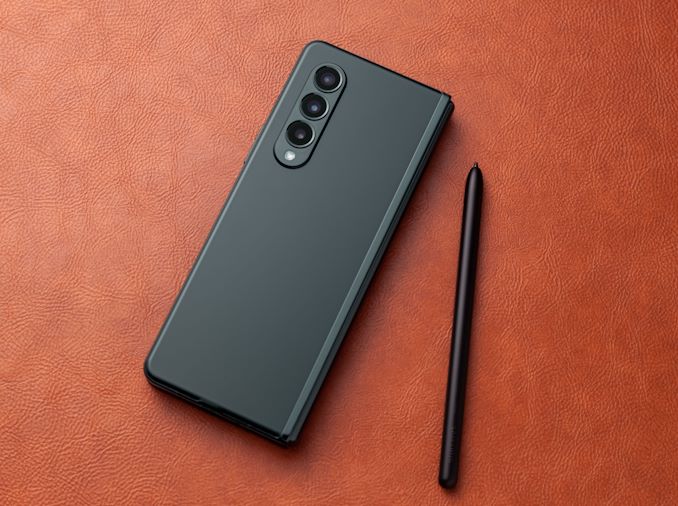
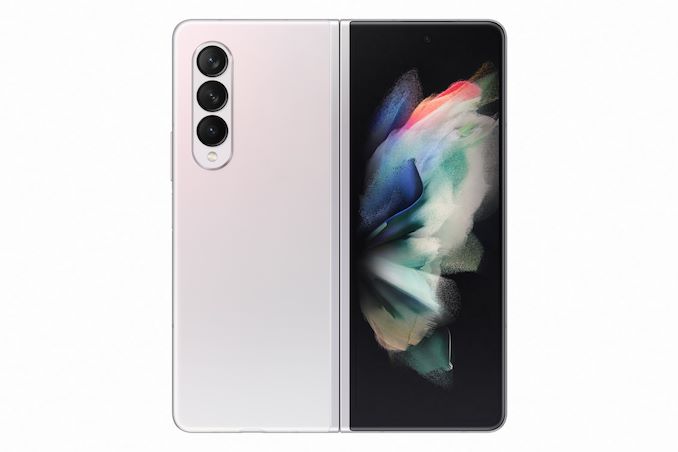
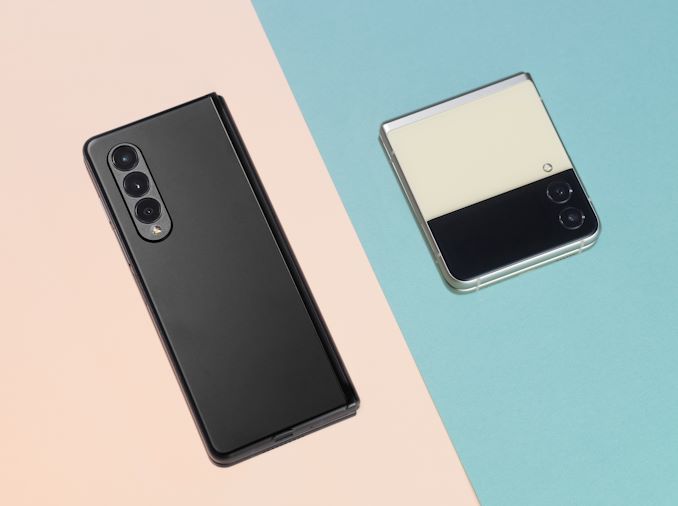
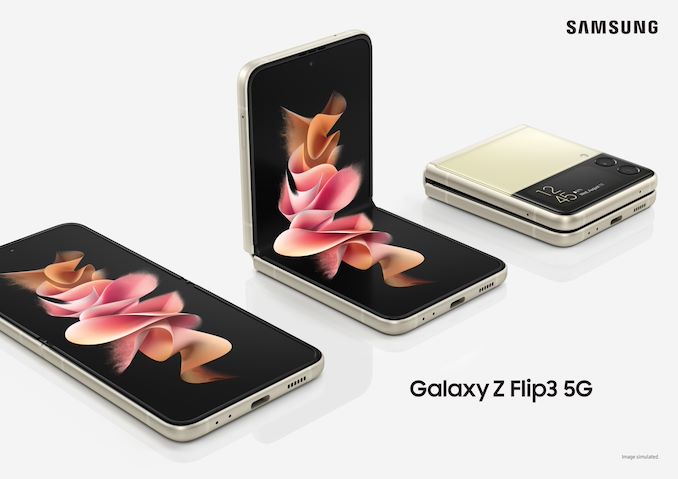
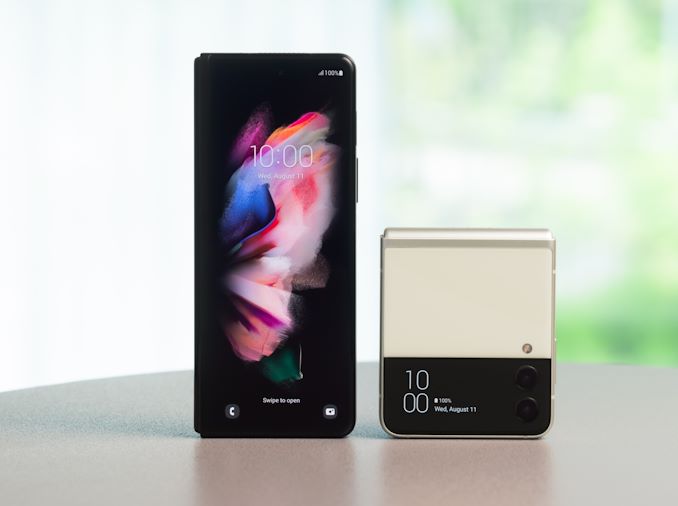
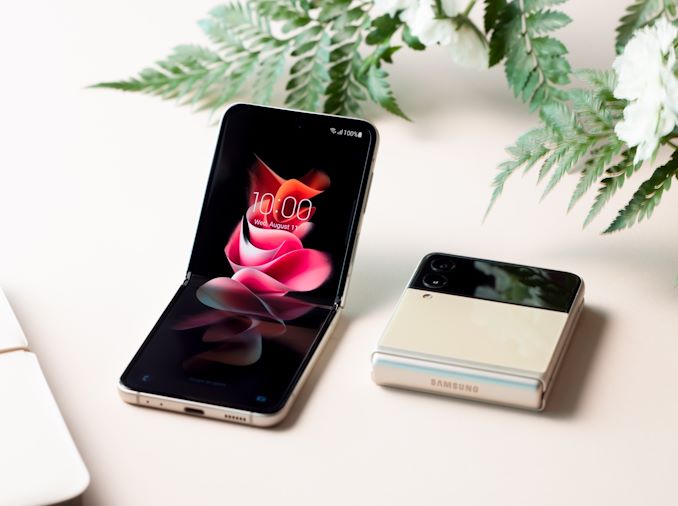
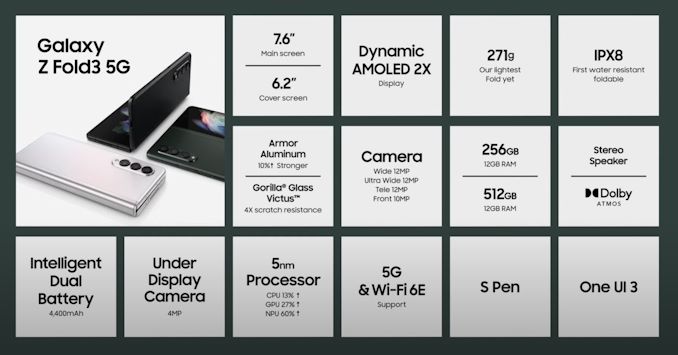
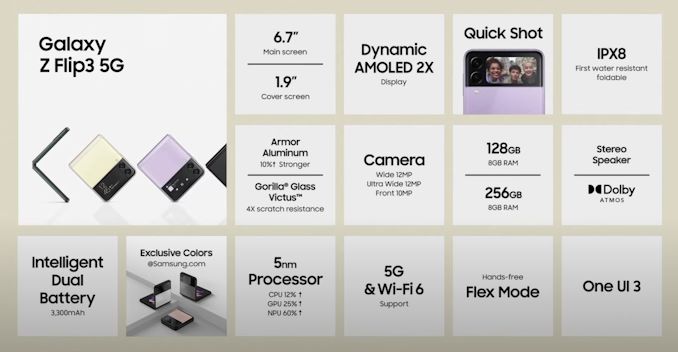








49 Comments
View All Comments
ballsystemlord - Wednesday, August 11, 2021 - link
The real question for this generation is what the battery life is like, as all of the phones thus far with the Snapdragon 888 APU have had poor battery life.Maxpower27 - Wednesday, August 11, 2021 - link
The S21 Ultra has excellent battery life.Wrs - Wednesday, August 11, 2021 - link
Want battery life? Don't get a phone with 3 screens lol. At this stage I feel it's mostly for vanity. The Fold costs as much as a Note + a pro tablet or laptop, but compromises on the battery, single SoC, camera quality, and screen crease if you're using it for leisure. The Flip is closer to a regular phone with the added perk of the tripod-less camera and the ability to fit into shallow pockets. Half the story is about insufficient pockets!sharath.naik - Thursday, August 12, 2021 - link
Battery is only 4400, the internal screen is 120hz and brighter than before. hmm. I guess 6 hours max with the screen open? Shouldn't they be providing >6000mah batteries for screen sizes like these?cfenton - Wednesday, August 11, 2021 - link
These things still aren't for me, but I'm happy to see the price on the Flip start to come down. If the launch price is $1000, you'll probably be able to get it for ~$700 in a few months. The Fold remains in koo-koo crazy land.nerd1 - Wednesday, August 11, 2021 - link
Not a single mention of added water resistance and pen support (both the first for folderable device)?And $1799 is not "extremely expensive". It is only $400 more expensive than rather bland iPhone 12 Pro Max 512GB.
vanilla_gorilla - Wednesday, August 11, 2021 - link
"And $1799 is not "extremely expensive". It is only $400 more expensive than rather bland iPhone 12 Pro Max 512GB."So it's ~25% more expensive than one of the most premium, high end phones? The literal most expensive iPhone you can buy? On what planet is that not "extremely expensive" ? The iPhone was already "extremely expensive" to the vast majority of humans.
trivik12 - Wednesday, August 11, 2021 - link
This is not a normal phone. This is new in class foldable where inner screen is a tablet. Obviously we are in early days and so its early adopters are not mainstream. But the fact that prices are dropping is a plus. I will wait another 2 generations before looking at it. So no comparisons to normal candybar phones.FunBunny2 - Wednesday, August 11, 2021 - link
" On what planet is that not "extremely expensive" ? "of course it is. this is a perfect example of The Tyranny of Fixed Cost - the machinery to make these widgets is, more or less, unique to them. with such a low volume output, the average cost is driven by the need to amortize all that bespoke capital. it's the chicken/egg problem - lower the price to what it could be with 10x or 100x expected sales at release (and sky high price on low volume) and hope/expect that said price will, in fact, generate such sales.
the other side of the situation is far more typical - calculate the average cost based on limited expected sales due to such high average price and suck up that revenue for a while and, may be, lower the cost/price once they've retired Y% of that capital cost.
going the latter way reveals that Samsung has little to no confidence in these devices. they're likely right.
vortmax2 - Friday, August 13, 2021 - link
First, it's $200 LESS at launch than the Fold 2, I'd call that a good effort by Samsung to lower the price, while upgrading it at the same time (120hz, IPX8, s-pen, cpu, gpu, ext.). Second, I got mine for $1000 through pre-order, WITH $200 Samsung credit, WITH 12% Rakuten cash back, PLUS, a free upgrade to 512gb, and an extra $100 on my S21 trade.Samsung is clearly trying to get these into the mainstream user as I believe foldable phones are the inevitable, and logical design for most future phones.